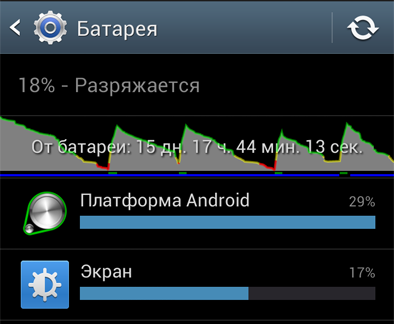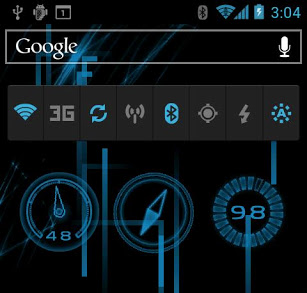Top 5 Tips to Increase Android Phone Running Time
 The running time of the phone on Android is a constant headache. That is why this issue is discussed endlessly on sites such as Mobile Nations or XDA Developers - ROM developers and modders are trying to find the optimal combination of hardware and software that would last as long as possible.
The running time of the phone on Android is a constant headache. That is why this issue is discussed endlessly on sites such as Mobile Nations or XDA Developers - ROM developers and modders are trying to find the optimal combination of hardware and software that would last as long as possible.(Image of "The Hungry Android" made by thefjk )
To date, there are more than 900,000,000 Android phones in the world, according to information sounded on Google I / O 2013, and this number continues to grow.

For us, as manufacturers of high-capacity batteries, this is a good indicator, but according to our gamer users, even the high-capacity battery life at 6400mAh for Note 2 is not enough, so today we will forget about batteries as a solution to the problem and present it to your attention universal TOP 5 tips to help you increase the time your phone works on Android.
')
 Not the news that in most cases, besides the Android OS itself, the screen consumes the most energy on Android. In second place is the search and use of signals (network and 3G, Wi-Fi) - in places with poor communication, the phone begins to consume more energy.
Not the news that in most cases, besides the Android OS itself, the screen consumes the most energy on Android. In second place is the search and use of signals (network and 3G, Wi-Fi) - in places with poor communication, the phone begins to consume more energy.In order to understand which programs and processes consume the most energy on the phone, you need to enter so many different emotions in the Settings-> Battery menu (or Settings-> About device-> Battery in earlier versions of Android).
If you have the desire, share your screenshot - we will gladly see your indicators in the comments! Do not forget to specify your phone model!
So, TOP 5:
1. Standard Power Control Widget Many widgets can have a lot of energy, but this one is designed specifically to help us quickly and quickly turn WiFi, BlueTooth, Sound, Sync, and so on on and off. Add this widget to one of the working panels:

On the Galaxy S4, this functionality was added to the Notification Bar with the ability to switch views, which is very convenient!

We also recommend trying the Power Toggles widget.
2. 3G network.

Usually, after the screen, the most energy goes to 3G, EDGE and GPRS. Today, the possibility of mobile Internet access is one of the main reasons for acquiring smartphones, but this does not mean that 3G should work all the time. Disable 3G can be in Settings-> Advanced Settings-> Mobile Networks-> Mobile Data. On S4, Mobile Data can be turned off via the Alerts Panel. For all other phones, we recommend the Power Toggles widget (see 1) - it allows you to turn 3G on and off with one touch.
Depending on your tariff, such control over access to the mobile Internet will also help you to save not only energy, but also money;)
3. "Breaking Bad Apps" - Old and poorly written applications .
 Many applications continue to work behind the scenes, even if you have not opened them for a very long time. In most cases, this is normal, and if the application is written in accordance with the recommendations from Android Dev , it provides quick access to the application and saves the resources that are needed to start the application from scratch, including energy. As mentioned in another article , the fact that RAM memory is completely full on Android is a completely normal phenomenon, aimed at increasing productivity , and not vice versa. Problems begin when the application does not just leave the running process for quick access, but continues to work behind the scenes. This leads to a loss of energy, and therefore we recommend to catch such applications through the menu Settings-> Battery and delete. Also, we recommend analyzing bloatware - applications that are usually preinstalled on the phone, which cannot be removed. If you see that you do not need any of them at all, but at the same time it eats a lot of energy, you can turn it off in the Application Manager.
Many applications continue to work behind the scenes, even if you have not opened them for a very long time. In most cases, this is normal, and if the application is written in accordance with the recommendations from Android Dev , it provides quick access to the application and saves the resources that are needed to start the application from scratch, including energy. As mentioned in another article , the fact that RAM memory is completely full on Android is a completely normal phenomenon, aimed at increasing productivity , and not vice versa. Problems begin when the application does not just leave the running process for quick access, but continues to work behind the scenes. This leads to a loss of energy, and therefore we recommend to catch such applications through the menu Settings-> Battery and delete. Also, we recommend analyzing bloatware - applications that are usually preinstalled on the phone, which cannot be removed. If you see that you do not need any of them at all, but at the same time it eats a lot of energy, you can turn it off in the Application Manager.4. Wakelock Detector application.
If you notice that the screen of your phone does not turn off, although it should, or that it suddenly turns on without warning, then most likely there are so-called wakelock applications installed on your phone (wakelocks). To find them, XDA Developers recommend the Wakelock Detector app. With this application you can significantly reduce the consumption of energy screen.
5. Do not use Task Killers. As we have already written, popular Process Killers do not show the average user the difference between good and bad applications, so the habit of constantly closing all processes with their help leads to the fact that in addition to energy consumption by the task killer itself, restarting applications closed by it leads to additional costs energy. In case the RAM memory is full, Android will close the hung or unused processes for a long time. Task killers are not needed to search for poorly working applications or wavelets - use the menu Settings-> Battery and Wakelock Detector. To remove applications, use the Application Manager, and for recovery, My Applications on Google Play.
If you have any add-ons, tips, recommendations on apps, please leave a comment! We will be glad to add this article with useful information!
Thanks for attention!
Mugen Power Batteries Team
mugen-power-batteries.ru
Source: https://habr.com/ru/post/181538/
All Articles